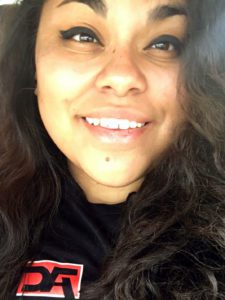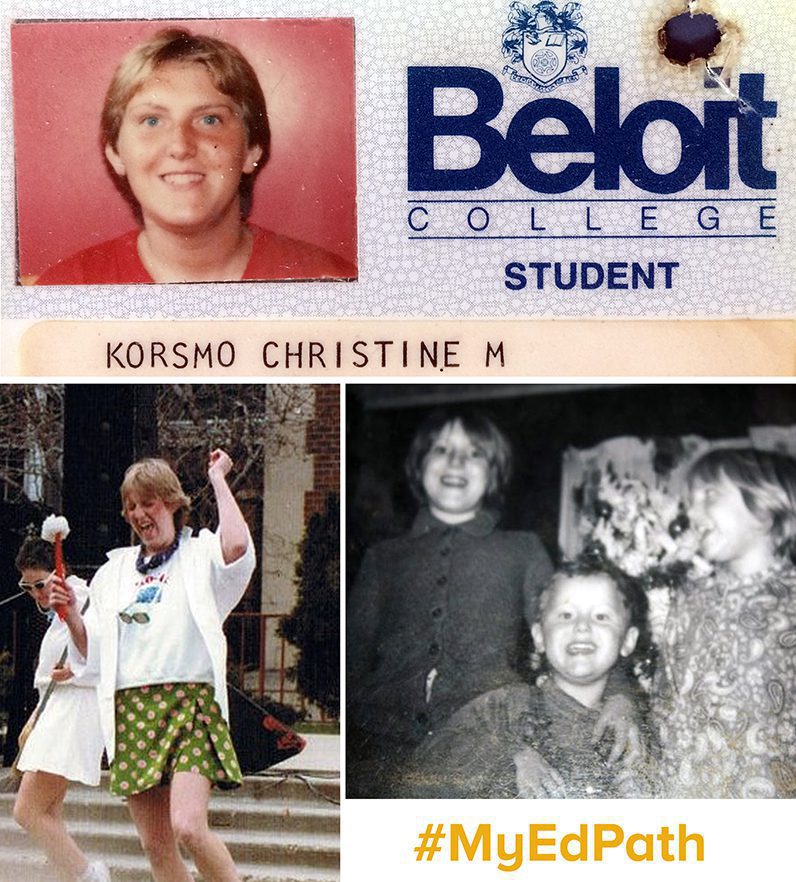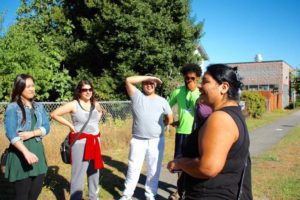By MyKaila Young, LEV Intern
 During my sophomore year through the helpful guidance of a great mentor of mine, I was admitted into the Masters in Education Policy class at the University of Washington. It sounds really impressive but, truth be told, I was terrified. I was in a class with current teachers, Masters candidates, and students in the processes of pursuing a doctoral degree. I was just a sophomore who wanted to be part of revamping the current education system. I had no knowledge of how advocating for policy changes worked. I didn’t know if I would ever have the confidence to challenge the very people who had so much power over my K-12 schooling. All I really had was my experiences and memory of the great fight that I put up to make it through the system by any means necessary.
During my sophomore year through the helpful guidance of a great mentor of mine, I was admitted into the Masters in Education Policy class at the University of Washington. It sounds really impressive but, truth be told, I was terrified. I was in a class with current teachers, Masters candidates, and students in the processes of pursuing a doctoral degree. I was just a sophomore who wanted to be part of revamping the current education system. I had no knowledge of how advocating for policy changes worked. I didn’t know if I would ever have the confidence to challenge the very people who had so much power over my K-12 schooling. All I really had was my experiences and memory of the great fight that I put up to make it through the system by any means necessary.
The first day of my graduate class was actually the first day of my bio anthropology class. Evolution never really intrigued me until I changed the perspective. The first chapter and lecture was on the evolution of birds. It’s not a super exciting topic but I worked with it. The book gave a very bland example of birds in the Galapagos Islands and how they changed or “evolved” over time. It was tragic (not really) in the sense of birds evolving over time and eventually dying off. There were birds with small beaks and birds with larger beaks. In hindsight, there was a variety of birds that carried their own unique traits, some that carried advantages within their own birthright, and some that did not have any advantages at all. A drought happened, which caused the seeds – the main food supply on the small island – to become enlarged. The disadvantaged birds were the ones that had smaller beaks. They couldn’t eat the larger seeds once they became enlarged due to the drought. They were disadvantaged because they were not physically equipped to break down or swallow the enlarged seeds that were produced by the environment. I remember thinking, “Well that sucks – how unfair.” The birds with the larger beaks were seen as the ones with the greatest advantage because they could in fact digest and eat the seeds, and take away the food supply from the disadvantaged. The only reason the larger-beaked birds survived over the smaller-beaked birds was because of their given or inherited advantages. The short-beaked birds died off because they found it impossible to survive without the proper resources. My professor mentioned that he believed that they tried to survive, but were unable because their disadvantages were just too great. That really intrigued me.
I remember not paying attention really until he started going in-depth about how there was always a “struggle for existence.” Learning how organisms have evolved and survived over time was fascinating in the sense that animals are not the only organisms that compete to survive in unruly or extremely disadvantaged environments.
One thing that I was reminded of this past week when I attended the Washington Student Achievement Council’s Pave the Way Conference in Tacoma was that, when it comes to education and the reality of the current system, receiving a quality and equitable education should no longer be a means of survival.
In society, an individual’s socioeconomic status (SES) is seen as a determinant in how a person is able to maintain, sustain and progress in life. Whether it be going to college or finding a career, SES in a sense allows you to see your advantages and disadvantages within the scope of your environment. The disadvantages within the environment are circumstances that can include addiction, poverty, abuse, neglect, and a wide range of other issues on top of a failing education system that a student is required to participate in.
The problem I see, as well as many advocates, is that the current system is not designed to support the advancement of every child. Instead, it’s tailored more to generalized outcomes than actual investments in advancements.
At some point in time, those who come from a particular SES – whether it be high, middle or low – that individual has to live in the “reality” of that status for some time. That’s a tough reality that we all have to face. We are given our disadvantages and advantages based on a status that is imposed on us at birth. I am sure there are many people much like myself who have looked at their surroundings while growing up and have said, “I didn’t ask for my life or parents to be this way,” or “I didn’t ask for all these problems.” Our survival abilities as humans come from how we deal with our unruly environments and imposed status and realities, but for most kids who are counting on the education system to help them to make it out and have a better chance at life, that’s failing them as well.
We need to stop expecting children to have the answers to overcoming poverty because there isn’t a special algorithm, especially when a quality education isn’t yet an option for everyone who wants one.
I haven’t heard of a school system that has properly equipped, fully funded without question, and strategically and morally invested in giving every child the proper resources to achieve. Instead, I continue to see a child’s background and SES being used as a shield or a reason to not fully invest, because they are seen as not as having as much potential as students who come from moderately stable (if not extremely stable) environments. It is not up to the system to decide who has the most potential and who is worth investing in, and who is not. That decision should be left up to the child.
Just as those short-beaked birds didn’t choose to be born in what would later on be considered as a “disadvantage,” they had no choice but to figure out a way to survive within their environment and to make that disadvantage work, or literally die trying. People do not choose to be born into harsh situations and environments. I can’t imagine someone waking up and saying to themselves, “Today seems like a great day to be burdened with hunger or extreme poverty.” I couldn’t imagine a child choosing to be in that position or in disadvantaged environment as a direct result of their family’s socioeconomic status. I strongly believe that McCleary is trying to get the very people who have the power to change the life experience of every child through a quality, immersive, and fully funded education.
We see in today’s society the rich getting richer, the poor getting poorer, and those in-between making it, but barely making it. Even within school districts, we see certain schools that have more access to resources because they are performing at higher levels than the schools who do not, which is only a direct result of not having a multitude of resources on top of the imposed realities that their education conveys to them. That was one of the strongest points that I heard at the Pave the Way Conference.
McCleary is helping to ensure that the decision is left up to the child and not the system. It only makes sense to invest in all students equally because if not, that sounds illegal.
At the Pave the Way Conference, I remember checking the agenda of breakouts after the morning speaker, Gary Orfield, finished his powerful address. He focused on the impact of policy and equal opportunity for success in American society. I checked my agenda and took notice that one of the sessions was about the “Realities of Poverty.”
One of the main goals of the session was to educate individuals on how poverty affects the development of an individual’s self-concept and influences a person’s values and beliefs. One thing that really resonated with me was that, when it comes to creating policies and truly advocating for kids from various backgrounds who may be experiencing various levels of poverty, there must a deeper understanding of how barriers are built within children that burden them every morning they walk through the doors of their respected schools. We have to see how poverty becomes a frequent reality for tomorrow’s adults, which is primarily due to a social system that does not provide pathways out of poverty that are realistic and long term, but instead generalized investments for expected outcomes.
I think McCleary is challenging the very people who have the power to create change within the current education system in the state of Washington. I believe that McCleary is asking what they are really afraid of.
The Pave the Way “Realities of Poverty” session went into great detail about how, in today’s society, we are socialized to judge and to not fully be aware, which causes us to miss out on the understanding piece. The facilitator gave a powerful example of how she once saw a man with rotten teeth and her first thought was, “He must be on drugs,” instead of taking a step back and thinking about our American society where over 40% of underserved communities do not have access to quality, affordable healthcare. Maybe his teeth were rotten because he does not have the means to see a dentist. She then went on to speak about how children see themselves through what is given/expected of them. McCleary could allow every student in the state of Washington to know that they will survive and access the American dream. After all, today’s children are tomorrow’s adults.
Read MyKaila’s third post, Could McCleary be Asking for More Inspiration?
 By Lisabeth Jiménez
By Lisabeth Jiménez

 The
The  The
The 
 Part of defining basic education is determining what each and every student should have access to in their school. Currently, our system does not guarantee access to student supports that are critical to many students’ academic success—including support staff like counselors or nurses, and programming like additional tutoring. There are a number of approaches we can take to making sure that students receive the supports and resources they need.
Part of defining basic education is determining what each and every student should have access to in their school. Currently, our system does not guarantee access to student supports that are critical to many students’ academic success—including support staff like counselors or nurses, and programming like additional tutoring. There are a number of approaches we can take to making sure that students receive the supports and resources they need. There isn’t a law that forbids any one of us from understanding how capable we are or how capable we are allowed to be. A few posts back, I mentioned my friend
There isn’t a law that forbids any one of us from understanding how capable we are or how capable we are allowed to be. A few posts back, I mentioned my friend